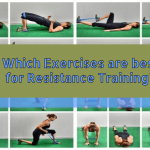If you’ve ever embarked on a fitness journey or simply aimed to strengthen your core, chances are you’ve encountered sit-ups as a staple exercise. Sit-ups have been a tried-and-true method for building abdominal strength and endurance for decades. But what makes them so enduringly popular, and what are the real benefits of incorporating sit-ups into your workout routine?
In this blog post, we’ll dive deep into the world of sit-ups and explore the numerous advantages they offer for your overall fitness and well-being. Whether you’re a fitness enthusiast looking to fine-tune your core or a beginner seeking effective ways to tone your midsection, understanding the best benefits of sit ups is a crucial step in achieving your fitness goals.
So, let’s get started and discover why sit-ups continue to be a go-to exercise for many fitness enthusiasts around the world.
Table of Contents
What are the Best Benefits of Sit ups?
If you’ve ever embarked on a fitness journey or simply aimed to strengthen your core, chances are you’ve encountered sit-ups as a staple exercise. Sit-ups have been a tried-and-true method for building abdominal strength and endurance for decades. But what makes them so enduringly popular, and what are the real benefits of incorporating sit-ups into your workout routine?
In this blog post, we’ll dive deep into the world of sit-ups and explore the numerous advantages they offer for your overall fitness and well-being. Whether you’re a fitness enthusiast looking to fine-tune your core or a beginner seeking effective ways to tone your midsection, understanding the best benefits of sit-ups is a crucial step in achieving your fitness goals.
So, let’s get started and discover why sit-ups continue to be a go-to exercise for many fitness enthusiasts around the world.
What are the Best Benefits of Sit ups?

Sit ups, a classic core exercise, offer a multitude of benefits for your overall fitness and well-being. These exercises primarily target the rectus abdominis, transverse abdominis, and obliques, working in harmony to strengthen and tone your core. But that’s not all; situps also engage your hip flexors, chest, and neck muscles, providing a comprehensive workout experience.
By incorporating situps into your fitness program, you can enjoy the advantages of improved posture, thanks to the engagement of your lower back and gluteal muscles. With their simplicity and effectiveness, situps stand out as a foundational exercise, and their variations cater to different fitness levels and goals.
Whether you opt for traditional situps or explore the range of motion in various styles, you’re sure to reap the rewards of enhanced core strength and better overall health. So, it’s clear that situps go beyond being a simple exercise; they are a key component of a well-rounded fitness routine, contributing to your physical well-being and promoting good posture while ensuring a strong and stable core.
The Best Benefits of Sit Ups

Incorporating sit-ups into your workout routine is a common practice, thanks to their time-tested simplicity and remarkable effectiveness as traditional core exercises. Here, we’ll explore several compelling reasons why adding sit-ups to your fitness regimen can be a beneficial choice.
Improved muscle mass
Sit-ups, a staple in fitness routines, hold profound significance when it comes to enhancing muscle strength, particularly in the abdominal and hip muscles. These simple yet potent exercises have proven to be an invaluable indicator, offering insights into muscle loss, especially among aging individuals.
A noteworthy 2016 research study shed light on the substantial benefits of sit-ups, particularly for older women. The findings revealed that those who could perform more than 10 sit-ups displayed higher levels of muscle mass and improved muscle function. This discovery holds promise as it underscores the potential to mitigate the natural loss of muscle, known as sarcopenia, which often accompanies the aging process.
As we delve deeper into the research and its promising results, the significance of sit-ups in preserving muscle strength and overall well-being among older women becomes increasingly apparent.
Core strength
Sit-ups, an integral component of fitness routines, serve as exceptional motivators for individuals seeking to enhance their core strength. These exercises, focused on strengthening, tightening, and toning the abdominal muscles, offer a wide array of benefits.
One of the most notable advantages is the significant reduction in the risk of experiencing back pain and injuries.
As individuals commit to sit-ups as part of their daily routine, they embark on a journey towards greater ease of movement in their daily activities and athletic pursuits.
This multifaceted approach to fitness not only promotes physical well-being but also aids in preventing potential discomfort and harm.
It’s clear that the incorporation of sit-ups into one’s exercise regimen can lead to a more active, injury-free lifestyle, and improved core strength is at the heart of these remarkable benefits.
Athletic performance
The advantages of incorporating sit-ups into your fitness regimen extend far beyond mere aesthetics. Sit-ups play a pivotal role in building strong core muscles, which are inextricably linked to improved muscular strength and endurance.
For athletes, this translates into enhanced performance at higher levels, enabling them to excel in their chosen sports and physical activities. A robust core not only ensures proper posture and stability but also empowers individuals to maintain optimal form during their workouts. This, in turn, minimizes the risk of injury and promotes an overall sense of well-being.
Furthermore, as fatigue becomes less of a barrier, the experience of engaging in various physical activities becomes more enjoyable and sustainable. Sit-ups, with their profound benefits for core strength, prove to be a valuable asset in the pursuit of athletic excellence and an active, fulfilling lifestyle.
Increased flexibility
Sit-ups, often underestimated in their capacity, offer a multitude of benefits that extend far beyond the realm of core strength. These exercises, in their dynamic nature, play a pivotal role in promoting spinal health. As you engage in sit-ups, the deliberate movement of your spine helps to loosen up stiffness that may have accumulated over time.
This newfound freedom of movement not only alleviates tension and tightness but also enhances the flexibility of your hips and back. This increased flexibility translates to improved mobility, enabling you to move with greater ease and grace in your daily life.
Furthermore, the benefits ripple throughout your body, as enhanced circulation and reduced stress levels are byproducts of this practice.
The sharpened concentration and boosted energy levels you experience after incorporating sit-ups into your routine are testaments to their holistic advantages.
In essence, sit-ups, with their capacity to alleviate stiffness, enhance flexibility, and invigorate the mind and body, are a remarkable asset to overall well-being.
Better balance and stability
The remarkable benefits of sit-ups extend well beyond a sculpted core. Sit-ups, by enhancing the strength of your abdominal muscles, contribute significantly to maintaining a strong core. This robust core plays a pivotal role in keeping your body balanced and stable during both daily and athletic activities.
As you engage in these exercises, your pelvis, lower back, and hip muscles work in harmony with your abdominal muscles, creating a synergy that promotes stability. This newfound stability not only aids in maintaining good balance but also reduces the likelihood of falling and injuring yourself during physical endeavors.
By helping your body move with grace and precision, sit-ups empower you to lead an active life with confidence, all while safeguarding against potential injuries. It’s clear that the holistic benefits of sit-ups go far beyond aesthetics, nurturing a resilient and well-balanced body for a fulfilling lifestyle.
Improved posture
Sit-ups, often underappreciated for their multifaceted benefits, play a pivotal role in nurturing a strong and solid core. Building this core strength has far-reaching advantages, particularly in maintaining the alignment of your hips, spine, and shoulders.
As your core becomes more robust through sit-up exercises, achieving good posture becomes easier and more natural. This improved alignment not only results in less pain and tension but also yields increased energy levels and enhanced breathing capacity.
The cumulative effects of sit-ups extend beyond mere aesthetics, providing a holistic improvement in overall well-being. With sit-ups as a core component of your fitness routine, you’ll find yourself not only looking better but feeling better, too, thanks to the remarkable benefits they offer for posture, pain relief, energy levels, and breathing.
Academic achievement
Sit-ups, often seen as a fundamental exercise for physical fitness, can yield surprising benefits that extend beyond the realm of physical health. Recent research, exemplified by a notable 2019 study, has revealed an intriguing connection between sit-ups and academic achievement, particularly among children. This study found a strong link between high fitness levels and high academic achievement levels in young students.
Remarkably, those who scored high in the sit-up segment of a comprehensive test, encompassing eight activities, exhibited significantly higher academic achievement levels at the two-year follow-up compared to their counterparts who scored lower in this area.
This positive effect highlights the holistic advantages of sit-ups, showcasing their potential to contribute not only to physical well-being but also to cognitive development and educational success. As we delve deeper into the multifaceted benefits of sit-ups, it becomes evident that these simple exercises hold the potential to foster a healthy body and an active mind, making them a valuable addition to any fitness routine.
Diaphragm strengthening
Sit-ups, often hailed as a great way to enhance core strength, offer a multifaceted array of benefits. These exercises, when practiced regularly, exert a positive effect on diaphragmatic breathing by promoting compression of the abdomen. This compression not only strengthens the diaphragm but also leads to improvements in breathing patterns.
A strong and healthy diaphragm, as revealed by the findings of a 2010 study, can alleviate stress and enhance athletic endurance. While this small study showed the effects of sit-ups on respiratory function, larger and more in-depth studies are needed to further expand our understanding of the potential benefits.
Sit-ups, with their potential for diaphragmatic strengthening and stress reduction, hold promise as an essential component of a comprehensive fitness routine, enriching both physical and mental well-being.
Reduced risk of back pain and injury
Sit-ups, often included in exercise programs, are renowned for their ability to build strength in various key areas of the body, including the lower back, hips, and pelvis. This comprehensive strengthening of the core plays a vital role in promoting a solid and firm center, thereby reducing the likelihood of experiencing back pain and injury.
While there has been a common belief that sit-ups may lead to musculoskeletal injuries, a comprehensive 2010 study involving U.S. Army soldiers dispelled this notion. The study’s findings revealed that the inclusion or exclusion of sit-ups in an exercise program yielded similar results in terms of musculoskeletal injuries.
It’s clear that when performed carefully and with proper technique, sit-ups prove to be not only beneficial but also capable of relieving back pain. These exercises, with their ability to strengthen the core and mitigate the risk of injuries, are a valuable addition to any fitness regimen, offering both physical resilience and relief from discomfort.
Some Sit up Exercises

Here are several sit-up exercises for you to attempt. Ensure that your movements are smooth, slow, and controlled, while maintaining proper form and technique. It’s advisable to practice these exercises on a soft mat or place a towel under your tailbone to provide additional support and comfort. During the exercises, you can maintain a slight curvature in your spine.
As you work on improving your core strength, aim to complete 2 to 3 sets of 10 to 15 repetitions, ideally three to five days per week. Remember to progress gradually, especially if you are new to core strengthening exercises, to prevent overexertion and ensure steady progress.
Traditional Sit ups
Traditional sit-ups are a classic and widely recognized abdominal exercise that targets the muscles in the abdominal area, particularly the rectus abdominis. To perform traditional sit-ups:
- Start by lying flat on your back on a comfortable surface, such as a mat or the floor.
- Bend your knees and place your feet flat on the ground, about hip-width apart.
- Cross your arms over your chest, or place your hands behind your head with your fingers lightly touching or interlocked behind your neck. Be careful not to pull on your neck during the exercise.
- Engage your core muscles by drawing your navel toward your spine.
- Exhale as you lift your upper body off the ground, bringing your chest toward your knees. Keep your lower back in contact with the floor.
- Inhale as you lower your upper body back down to the starting position, with your shoulder blades lightly touching the ground.
Traditional sit-ups primarily work the rectus abdominis, but they also engage the hip flexors, chest, and neck muscles to some extent. They are often used to strengthen and tone the abdominal muscles and are a fundamental exercise in many fitness routines.
However, it’s important to perform them with proper form to avoid straining your neck or lower back. If you have any underlying medical conditions or concerns, it’s advisable to consult with a fitness professional or healthcare provider before incorporating sit-ups into your workout routine.
Stability ball situps
Stability ball sit-ups, also known as Swiss ball sit-ups or exercise ball sit-ups, are a variation of traditional sit-ups or crunches that involve using an exercise stability ball. These sit-ups are performed to target and strengthen the abdominal muscles while adding an element of balance and stability training.
Here’s how to perform stability ball sit-ups:
- Begin by sitting on the stability ball with your feet flat on the floor and your knees bent at a 90-degree angle. The ball should be positioned so that your lower back is supported by the ball, and your torso is parallel to the ground.
- Cross your arms over your chest or place your hands behind your head, just as you would in traditional sit-ups.
- Engage your core muscles by drawing your navel toward your spine.
- Exhale as you slowly lean back, allowing your back to roll along the ball while maintaining balance. Keep your feet flat on the floor.
- Inhale as you use your abdominal muscles to lift your upper body back up to a seated position.
- Perform the desired number of repetitions, focusing on controlled movements and proper form.
Stability ball sit-ups are beneficial because they not only work the rectus abdominis (front of the abdomen) but also engage the stabilizing muscles of the core, including the obliques and lower back muscles. The unstable surface of the exercise ball challenges your balance and forces your core muscles to work harder to stabilize your body during the movement.
Like any exercise, it’s important to maintain proper form and start with a level of difficulty that matches your fitness level. If you’re new to stability ball sit-ups, consider starting with basic exercises on the stability ball to build stability and gradually progress to more challenging movements like sit-ups. Always consult with a fitness professional or healthcare provider if you have any concerns or underlying medical conditions before incorporating new exercises into your routine.
V-sits
V-sits, also known as V-ups, are an abdominal exercise that targets the core muscles, particularly the rectus abdominis and the hip flexors. This exercise is named after the V shape that your body forms during the movement. V-sits are effective for strengthening the abdominal muscles and improving core stability.
Here’s how to perform V-sits:
- Start by sitting on the floor with your legs extended in front of you and your feet together.
- Place your hands on the floor by your sides, with your palms facing down and your fingers pointing forward. Keep your arms straight throughout the exercise.
- Engage your core muscles by drawing your navel toward your spine.
- Lean back slightly while lifting your feet off the ground. Simultaneously, raise your upper body off the ground, bringing your torso and legs together to form a V shape.
- Keep your legs straight as you lift them, and try to touch your toes with your hands at the top of the movement. Your body should resemble a V shape.
- Hold the V position for a moment to engage your core muscles fully.
- Slowly lower your torso and legs back down to the starting position, returning your feet just above the ground without letting them touch the floor.
- Repeat the movement for the desired number of repetitions.
V-sits are an excellent exercise for building strength and definition in the abdominal muscles, as they involve both a crunching motion and the lifting of the legs. They also challenge your balance and stability, making them a versatile addition to your core workout routine. As with any exercise, it’s essential to maintain proper form to avoid straining your lower back or neck. Start with a manageable number of repetitions and gradually increase the intensity as your core strength improves.
Frequently Asked Questions
Do sit-ups reduce belly fat?
Sit-ups alone are not highly effective for reducing belly fat. A combination of cardio exercises, a balanced diet, and overall calorie reduction is more effective for fat loss. Sit-ups can strengthen abdominal muscles but won’t spot-reduce fat in the belly area
What do situps do for your body?
Sit-ups primarily strengthen the abdominal muscles, including the rectus abdominis and obliques. They also engage hip flexors, chest, and neck muscles to some extent. Sit-ups are beneficial for core strength, stability, and can help improve posture when done correctly.
Is it beneficial to do sit-ups everyday?
Doing sit-ups every day may not be necessary and could potentially lead to overuse injuries. It’s often more effective to incorporate sit-ups into a well-rounded exercise routine that includes rest days for muscle recovery. Consult a fitness professional for personalized guidance on frequency and intensity.
Sit ups exercise benefits for male?
Sit-ups benefit males by strengthening core muscles, defining the abs, improving posture, enhancing functional strength, and contributing to overall fitness.
Benefits of sit-ups for females?
Sit-ups benefit females by strengthening the core, toning the abdominal area, improving posture, enhancing functional strength, and promoting overall health.
Indian sit-ups benefits?
Indian sit-ups, or “pada hasthasana” in yoga, offer benefits such as improved flexibility, stress reduction, better digestion, enhanced posture, strengthened legs, increased energy, improved mental focus, and potential relief from mild back pain.
Benefits of sit-ups for weight loss?
Sit-ups alone are not highly effective for weight loss. Weight loss primarily depends on a balanced diet and cardiovascular exercises. Sit-ups can contribute to muscle development, which may indirectly aid in weight loss by increasing metabolism.
How to do sit ups?
To do sit-ups:
- Lie on your back with bent knees.
- Cross your arms over your chest or place your hands behind your head.
- Engage your core.
- Lift your upper body towards your knees as you exhale.
- Lower back down as you inhale.
- Repeat for your desired reps, keeping your feet anchored.
What are the Standing sit-ups benefits?
Standing sit-ups can improve core strength, balance, and posture while engaging multiple muscle groups.
Conclusion
In conclusion, sit-ups offer a myriad of benefits that make them a valuable addition to any fitness routine. They are not only effective for strengthening the abdominal muscles but also engage other muscle groups, enhancing overall core stability. Regularly incorporating sit-ups into your workout regimen can lead to improved posture, better balance, and increased functional strength.
Moreover, the convenience of performing sit-ups without any special equipment makes them accessible to people of all fitness levels. Remember, like any exercise, proper form and moderation are key to reaping the best benefits of sit-ups while minimizing the risk of injury.
So, whether you’re looking to achieve a chiseled six-pack or simply improve your overall fitness, sit-ups are a versatile and effective exercise to consider.














